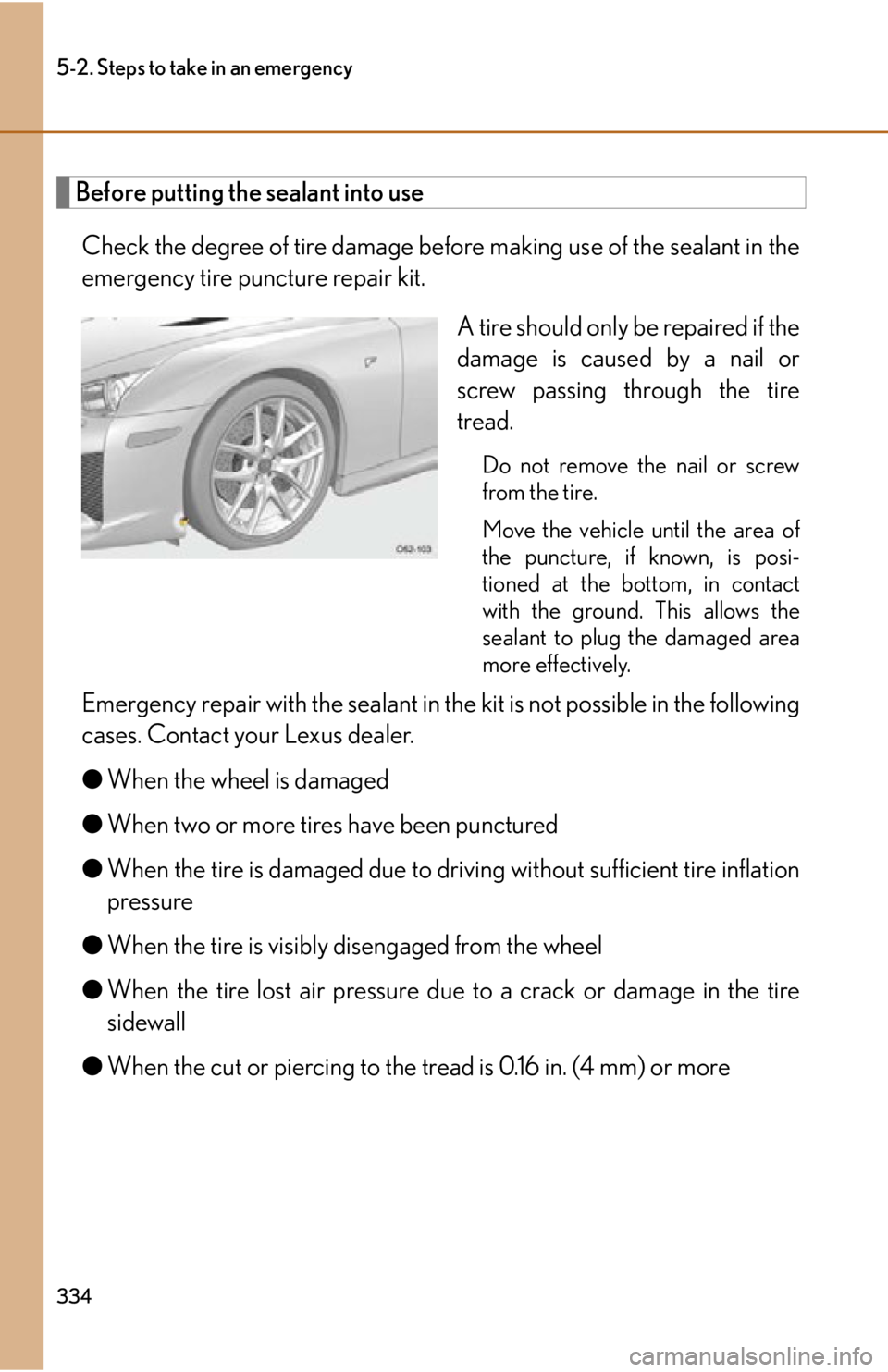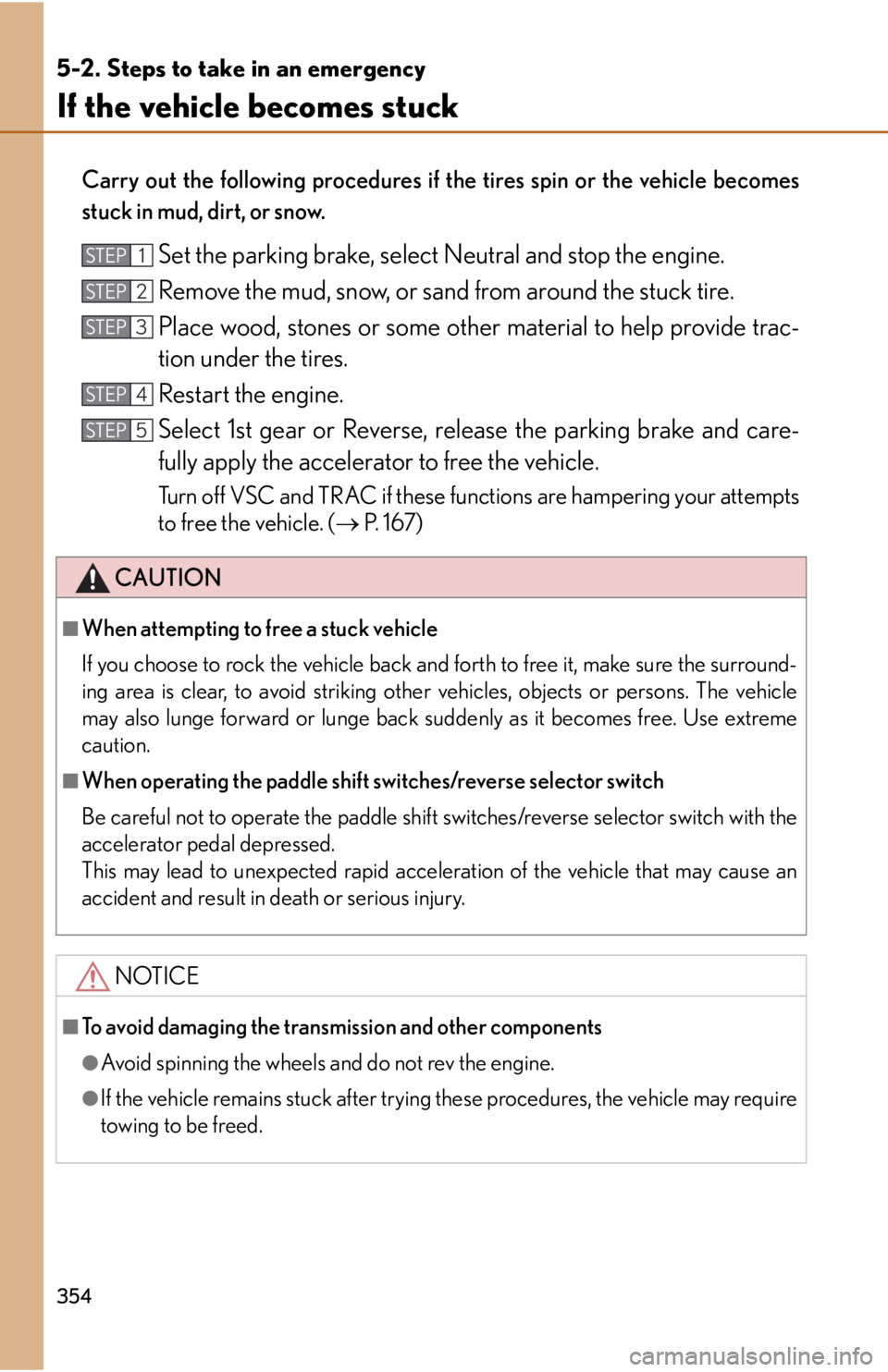2012 Lexus LFA wheel
[x] Cancel search: wheelPage 320 of 420

318
5-2. Steps to take in an emergency
■If the tire pressure warning system is not functioning
The tire pressure warning system will be disabled in the following conditions:
(When the condition becomes normal, the system will work properly.)
●If tires not equipped with tire pressure warning valves and transmitters are used
●If the ID code on the tire pressure warning valves and transmitters is not regis-
tered in the tire pressure warning computer
●If the tire inflation pressure is 73 psi (500 kPa, 5.1 kgf/cm2 or bar) or higher
The tire pressure warning system may be disabled in the following conditions:
(When the condition becomes normal, the system will work properly.)
●If electronic devices or facilities using similar radio wave frequencies are nearby
●If a radio set at similar frequencies is in use in the vehicle
●If there is a lot of snow or ice on the vehicle, particularly around the wheels or
wheel housings
●If non-genuine Lexus wheels are used (Even if you use Lexus wheels, the tire
pressure warning system may not work properly with some types of tires.)
●If a tire is repaired with the emergency tire puncture repair kit
■If the tire pressure warning light comes on after flashing frequently for 1 minute
If the tire pressure warning light comes on after flashing frequently for 1 minute
when the ignition switch is turned to th e “ON” position, have it checked by your
Lexus dealer.
■Customization that can be configured at Lexus dealer
The vehicle speed linked seat belt reminder buzzer can be disabled.
(Customizable features P. 383)
Page 321 of 420

5
When trouble arises
319
5-2. Steps to take in an emergency
CAUTION
■When the electric power steering system warning light comes on
The steering wheel may become extremely heavy.
If the steering wheel becomes heavier than usual when operating, hold firmly and
operate using more force than usual.
■If the tire pressure warning light comes on
Be sure to observe the following precaution s. Failure to do so could cause a loss of
vehicle control and result in death or serious injury.
●Stop your vehicle in a safe place as soon as possible. Adjust the tire inflation pres-
sure immediately.
●If the tire pressure warning light comes on even after tire inflation pressure adjust-
ment, it is probable that you have a flat tire. Check the tires. If a tire is flat, tempo-
rarily repair the tire using the em ergency tire puncture repair kit ( P. 3 3 2 ) a n d
then have the tire repaired or replaced by the nearest Lexus dealer.
●Avoid abrupt maneuvering and braking. If the vehicle tires deteriorate, you could
lose control of the steering wheel or the brakes.
■If a blowout or sudden air leakage should occur
The tire pressure warning system may not activate immediately.
Page 322 of 420

320
5-2. Steps to take in an emergency
CAUTION
■Maintenance of the tires
Each tire, including the spare (if provided), should be checked monthly when cold
and inflated to the inflation pressure re commended by the vehicle manufacturer on
the vehicle placard or tire inflation pressu re label (tire and load information label).
(If your vehicle has tires of a different size than the size indicated on the vehicle
placard or tire inflation pressure label [tire and load information label], you should
determine the proper tire inflation pressure for those tires.)
As an added safety feature, your vehicl e has been equipped with a tire pressure
monitoring system (TPMS-tire pressure warning system) that illuminates a low tire
pressure telltale (tire pressure warning light) when one or more of your tires is sig-
nificantly under-inflated. Accordingly, when the low tire pressure telltale (tire pres-
sure warning light) illuminates, you should stop and check your tires as soon as
possible, and inflate them to the proper pressure. Driving on a significantly under-
inflated tire causes the tire to overheat and can lead to tire failure. Under-inflation
also reduces fuel efficiency and tire tread life, and may affect the vehicle's handling
and stopping ability.
Please note that the TPMS (tire pressure warning system) is not a substitute for
proper tire maintenance, and it is the driv er's responsibility to maintain correct tire
pressure, even if under-inflation has not reached the level to trigger illumination of
the TPMS low tire pressure telltale (tire pressure warning light).
Your vehicle has also been equipped with a TPMS (tire pressure warning system)
malfunction indicator to indicate when th e system is not operating properly. The
TPMS (tire pressure warning system) malfunction indicator is combined with the
low tire pressure telltale (tire pressure warning light). When the system detects a
malfunction, the telltale will flash for approximately one minute and then remain
continuously illuminated. This sequence will continue upon subsequent vehicle
start-ups as long as the malfunction exists . When the malfunction indicator is illumi-
nated, the system may not be able to detect or signal low tire pressure as intended.
TPMS (tire pressure warning system) malfunctions may occur for a variety of rea-
sons, including the installation of replacem ent or alternate tires or wheels on the
vehicle that prevent the TPMS (tire pres sure warning system) from functioning
properly. Always check the TPMS (tire pressure warning system) malfunction tell-
tale after replacing one or more tires or wheels on your vehicle to ensure that the
replacement or alternate tires and wheels allow the TPMS (tire pressure warning
system) to continue to function properly.
Page 336 of 420

334
5-2. Steps to take in an emergency
Before putting the sealant into useCheck the degree of tire damage befo re making use of the sealant in the
emergency tire puncture repair kit.
A tire should only be repaired if the
damage is caused by a nail or
screw passing through the tire
tread.
Do not remove the nail or screw
from the tire.
Move the vehicle until the area of
the puncture, if known, is posi-
tioned at the bottom, in contact
with the ground. This allows the
sealant to plug the damaged area
more effectively.
Emergency repair with the sealant in the kit is not possible in the following
cases. Contact your Lexus dealer.
● When the wheel is damaged
● When two or more tires have been punctured
● When the tire is damage d due to driving without sufficient tire inflation
pressure
● When the tire is visibly disengaged from the wheel
● When the tire lost air pressure due to a crack or damage in the tire
sidewall
● When the cut or piercing to the tread is 0.16 in. (4 mm) or more
Page 342 of 420

340
5-2. Steps to take in an emergency
■Sealant
●One tire can be repaired using the bottle of sealant stored in the emergency tire
puncture repair kit.
●The sealant can be used when the outside temperature is from -22°F (-30°C)
to 140°F (60°C).
●When the outside temperature is low, the viscosity of the sealant becomes high
and it will be more difficult to inject th e sealant. In this case, warm the sealant in
the vehicle before using it.
●The sealant has a limited lifespan. The expi ration date is marked on the bottle.
The sealant should be replaced before the expiration date. Contact your Lexus
dealer.
●If the sealant gets on your clothes, it may stain.
●After using the sealant, bring the empty bottle of sealant to your Lexus dealer
and purchase a new bottle. Keep the ne w bottle of sealant in your vehicle.
■Compressor
●The compressor is a pneumatic filling type for passenger vehicles.
●When the compressor is operating, a loud operating noise will be produced.
This does not indicate a malfunction.
■The wheel of a tire that has been repaired
If you remove the sealant adhering to the wheel with a rag, you can reuse the wheel.
■The valve of a tire that has been repaired
●After a tire is repaired with the emergency tire puncture repair kit, the tire pres-
sure warning valve and transm itter should be replaced.
●After a tire is repaired with the emergency tire puncture repair kit, even if the
tire inflation pressure is at the recommended level, the tire pressure warning
light may come on/flash.
Page 343 of 420

5
When trouble arises
341
5-2. Steps to take in an emergency
CAUTION
■Precaution for children
Keep the emergency tire puncture repair kit out of the reach of children and store it
properly.
■Sealant precautions
●The sealant in the emergency tire puncture repair kit is not for human consump-
tion.
If the sealant is consumed, drink a large quantity of water and get medical atten-
tion immediately.
●If sealant gets in your eyes or on your skin, thoroughly wash with a large quantity
of water. If necessary, get medical attention.
■When fixing the flat tire
●Stop your vehicle in a safe and flat area.
●If force is used to turn the valve core tool while air remains in the tire, special care
should be taken because the valve core could fly out.
●Be careful, as sealant may fly out if you shake the bottle with the hose installed.
●If the hose is not securely installed, sealant may leak out when filling.
●Connect the valve and hose securely with the tire installed on the vehicle.
●Be careful handling the compressor, as parts of the compressor get hot during
operation. Some parts of the compressor may remain hot after use.
●Do not attach the vehicle speed warning sticker to an area other than the one
indicated. If the sticker is attached to an area where an SRS airbag is located,
such as the pad of the steering wheel, it may prevent the SRS airbag from operat-
ing properly.
■Driving to spread the liquid sealant evenly
Drive cautiously at a moderate speed, avoi ding sudden starts, sudden braking, and
abrupt steering maneuvers.
Page 344 of 420

342
5-2. Steps to take in an emergency
NOTICE
■Vehicles with a flat tire
Do not continue driving with a flat tire.
Driving even a short distance with a flat tire can damage the tire and the wheel
beyond repair.
■When performing an emergency repair
Perform the emergency repair without removing the nail or screw that has punc-
tured the tread of the tire. If the object th at has punctured the tire is removed, the
repair using the sealant in the emergenc y tire puncture repair kit may fail.
■When fixing the flat tire
●Do not put the valve core on dirty ground or in the sand.
Store it in a clean place.
●Do not remove the inside cap of the sealant bottle.
●Turn the valve core tool with your hand when screwing it in. If you use another tool
in conjunction with the valve core tool, damage may occur.
●Do not operate the compressor continuously for more than 10 minutes. The
motor may overheat and be damaged. Le t the compressor cool before using it
again.
■Compressor precautions
●The compressor power source should be 12 V DC suitable for vehicle use.
Do not connect the compressor to 24 V DC or any other power source.
●The compressor is an oil-less type. Do not lubricate with oil.
●If the compressor does not operate properly or becomes hot, it may be over-
heated. Turn off the switch and leave the compressor to cool down for at least 30
minutes.
●The compressor is not waterproof. Make sure that the compressor is not exposed
to water, such as when it is being used in the rain.
●Do not put the compressor directly onto dusty ground such as sand at the side of
the road. If the compressor vacuums up dust etc., a malfunction may occur.
●Do not disassemble or modify the compre ssor. Do not subject parts such as the
air pressure indicator to impacts. This may cause a malfunction.
Page 356 of 420

354
5-2. Steps to take in an emergency
If the vehicle becomes stuck
Carry out the following procedures if the tires spin or the vehicle becomes
stuck in mud, dirt, or snow.
Set the parking brake, select Neutral and stop the engine.
Remove the mud, snow, or sand from around the stuck tire.
Place wood, stones or some other material to help provide trac-
tion under the tires.
Restart the engine.
Select 1st gear or Reverse, release the parking brake and care-
fully apply the accelerator to free the vehicle.
Turn off VSC and TRAC if these functions are hampering your attempts
to free the vehicle. ( P. 1 6 7 )
CAUTION
■When attempting to free a stuck vehicle
If you choose to rock the vehicle back and forth to free it, make sure the surround-
ing area is clear, to avoid striking other vehicles, objects or persons. The vehicle
may also lunge forward or lunge back suddenly as it becomes free. Use extreme
caution.
■When operating the paddle shift switches/reverse selector switch
Be careful not to operate the paddle shift switches/reverse selector switch with the
accelerator pedal depressed.
This may lead to unexpected rapid acceleration of the vehicle that may cause an
accident and result in death or serious injury.
NOTICE
■To avoid damaging the transm ission and other components
●Avoid spinning the wheels and do not rev the engine.
●If the vehicle remains stuck after trying these procedures, the vehicle may require
towing to be freed.
STEP1
STEP2
STEP3
STEP4
STEP5